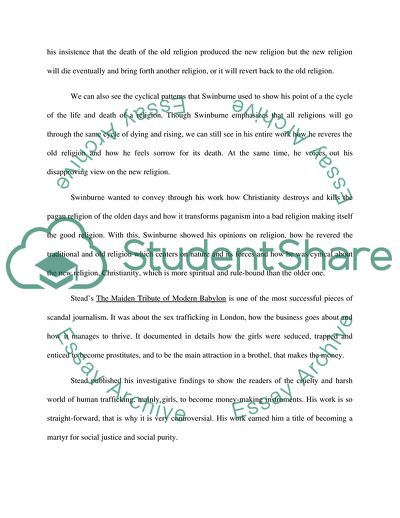
- Home
- Free Samples
- Premium Essays
- Editing Services
- Extra Tools
- Essay Writing Help
- About Us
- Studentshare
- Subjects
- Miscellaneous
- To be Determined
To be Determined - Essay Example

- Subject: Miscellaneous
- Type: Essay
- Level: Masters
- Pages: 4 (1000 words)
- Downloads: 0
- Author: osenger
Extract of sample "To be Determined"
Swinburne’s Hymn to Proserpine is a dramatic monologue that he wrote during the time that Christianity was at its peak and the old religion was put aside. He opposed to the religion and he spoke of deities and priests as prime persons in liberticide. The monologue’s tone is lamenting and sorrowful as it grieves over the death of paganism. The poem ends with a remark on the rising power of Christianity. And throughout the poem, the writer tries to point out that, the same as paganism, the new religion will also has its own end in time.
The poem starts and ends with a reference to Proserpine. And throughout the text, the use of paradox is prevalent. This is to show the irony and apparent contradiction of the old religion and the new religion. Proserpine is used as a main point of paradox, wherein she is the Goddess of Death and at the same time she brings forth the spring, and with it is life. This is used to show the writer’s point of view regarding the issue of the old religion and the new religion. This shows his insistence that the death of the old religion produced the new religion but the new religion will die eventually and bring forth another religion, or it will revert back to the old religion.
We can also see the cyclical patterns that Swinburne used to show his point of a the cycle of the life and death of a religion. Though Swinburne emphasizes that all religions will go through the same cycle of dying and rising, we can still see in his entire work how he reveres the old religion and how he feels sorrow for its death. At the same time, he voices out his disapproving view on the new religion. Swinburne wanted to convey through his work how Christianity destroys and kills the pagan religion of the olden days and how it transforms paganism into a bad religion making itself the good religion.
With this, Swinburne showed his opinions on religion, how he revered the traditional and old religion which centers on nature and its forces and
...Download file to see next pages Read MoreCHECK THESE SAMPLES OF To be Determined
Network Design for UMUC Branch Office
Business Law: The Case of Illegal Alcohol Selling
Contract Law: Cunningham vs. Driscoll
Douglas vs. Special Products
Business case studies
(need to be determined)
(need to be determined)
The Partnership Between Mr Walker and Mr Melham: Six Issues to be Determined by the Court

- TERMS & CONDITIONS
- PRIVACY POLICY
- COOKIES POLICY